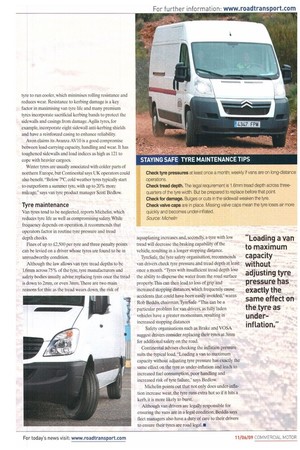Getting a grip on the future
Page 42

Page 43

If you've noticed an error in this article please click here to report it so we can fix it.
The latest generation of van tyres not only give good performance but can also increase fuel economy.
Words: Sharon Ctancy
Van tyre manufacturers have a tricky juggling act: drivers want car-like handling and performance. but as well as giving good performance the tyres need to be able to cope with loads and resist in-service damage.
Goodyear's GT2 and GT3, for example, are designed to handle the extra load ratings for car-derived vans, while Continental's Vanco 2 has more grooves to protect against aquaplaning than its predecessor and the tread pattern and compound are designed to deliver shorter braking distances. Michelin's Agilis is claimed to reduce wet-road braking distances by three metres compared with its predecessor, and Bridgestone's Duravis van tyres have a cap layer in the tread to provide durability at higher speed. The tread block has been designed for car-like handling at speed.
Increasingly, fuel economy is also a factor. While rolling-resistance has long been a feature of truck tyres, it has now started to feature prominently in van tyre design. By 2012 the current CO2 limits of 203g/km have to be cut to 175gitc.m.
Michelin claims the Agilis's fuel consumption is reduced by 0.2 litres per 100km, which equates to 4g/km of CO2. And if the green argument doesn't convince you, then perhaps Michelin's calculation that the fuel saving equates to the price of a new tyre after 85,000km will.
Goodyear's latest van tyre, the Cargo Marathon, incorporates technology from its Marathon truck tyres. Developed for vans on long-distance high-speed operations Cargo Marathon tyres have a block-shift tread pattern that is claimed to reduce tyre noise at speed. The tyre has wide grooves in the circumference to disperse water and reduce the risk of aquaplaning, while blades and a high silica content in the compound help grip.
Goodyear claims its GT3 tyre for car-derived vans saves up to 5% on fuel consumption. It uses Bio Tied technology that replaces oil derivatives and silica with ingredients derived from cornstarch.
Agilis tyres incorporate Michelin car tyre technology. The Durable Contact Patch minimises distortion in the shoulder and tread locks when the wheel turns, helping the tyre to run cooler, which minimises rolling resistance and reduces wear. Resistance to kerbing damage is a key factor in maximising van tyre life and many premium tyres incorporate sacrificial kerbing bands to protect the sidewalls and casings from damage. Agilis tyres, for example, incorporate eight sidewall anti-kerbing shields and have a reinforced casing to enhance reliability Avon claims its Avanza AV10 is a good compromise between load-carrying capacity, handling and wear. It has toughened sidewalls and load indices as high as 121 to cope with heavier cargoes.
Ninter tyres are usually associated with colder parts of northern Europe, but Continental says UK operators could also benefit. "Below 7°C, cold weather tyres typically start to outperform a summer tyre, with up to 20% more mileage," says van tyre product manager Scott Bedlow.
Tyre maintenance
Van tyres tend to be neglected, reports Michelin, which reduces tyre life as well as compromising safety. While frequency depends on operation, it recommends that operators factor in routine tyre pressure and tread depth checks.
Fines of up to £2,500 per tyre and three penalty points can he levied on a driver whose tyres are found to be in unroadworthy condition.
Although the law allows van tyre tread depths to be lAmm across 75% of the tyre, tyre manufacturers and safety bodies usually advise replacing tyres once the tread is down to 2mna, or even 3rnm. There are two main reasons for this: as the tread wears down, the risk of aquaplaning increases and, secondly, a tyre with low tread will decrease the braking capability of the vehicle, resulting in a longer stopping distance.
TyreSafe, the tyre safety organisation, recommends van drivers check tyre pressure and tread depth at least once a month. "Tres with insufficient tread depth lose the ability to disperse the water from the road surface properly. This can then lead to loss of grip and increased stopping distances, which frequently cause accidents that could have been easily avoided,warns Rob Becidis, chairman, TyreSafe "This can be a particular problem for van drivers, as fully laden vehicles have a greater momentum, resulting in increased stopping distances Safety organisations such as Brake and VOSA suggest drivers consider replacing their tyres at 3min for additional safety on the road.
Continental advises checking the inflation pressure suits the typical load. "Loading a van to maximum capacity without adjusting tyre pressure has exactly the same effect on the tyre as under-inflation and leads to increased fuel consumption, poor handling and increased risk of tyre failure," says Bedlow.
Michelin points out that not only does under-inflation increase wear, the tyre runs extra hot so if it hits a kerb, it is more likely to burst.
Although van drivers are legally responsible for ensuring the vans are in a legal condition, Beddis says fleet managers also have a duty of care to their drivers to ensure their tyres are road legal. •
















































































































































